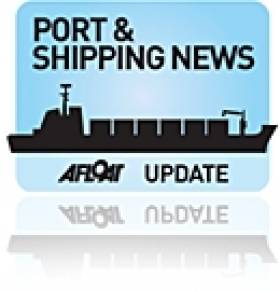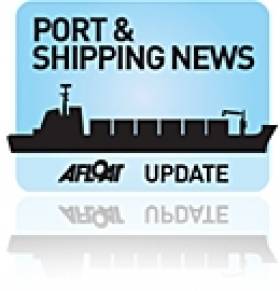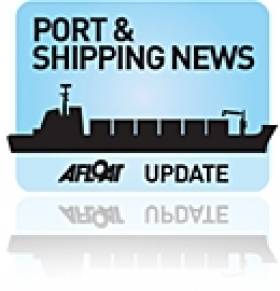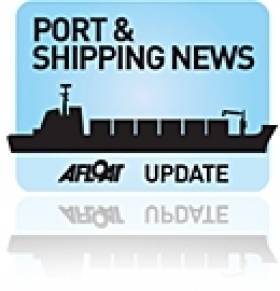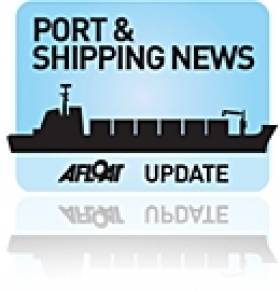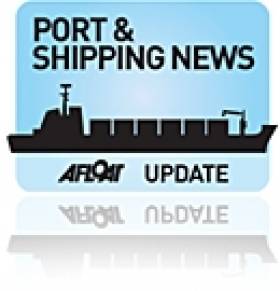Displaying items by tag: Ardmore Shipping
Ports & Shipping Review: EPSO Re-Elect Chairman, Ardmore's Finance Plan, Green Port Award, New Foynes Jetty, Double Ship Incidents and ISL 30th Anniverary
#Ports&ShippingReview: Over the last fortnight, Jehan Ashmore has reported on the shipping scene, where the European Sea Port Organisation (ESPO) re-elected Garcia-Milà as Chairman following a vote of the organisation's General Assembly held in Brussels.
Tanker fleet operator Ardmore Shipping Corporation announced financial results and a $20 million Share Repurchase Plan.
As referred above ESPO, has awarded this year the Slovenian port of Koper in recognition of its environmental work in creating a sustainable future for the port and its surroundings.
The name of the contractor for a €10m plus upgrade of the east jetty at Foynes will be announced shortly by Shannon Foynes Port Company.
Within a fortnight two separate incidents involving a pair of vessels berthed in Warrenpoint, took place at the Co. Down port. The first incident was an oil spill followed by an overheating cargo of animal feed.
A cargoship currently berthed in Dublin Port, Arklow Willow has a similar name to a former Irish Shipping Ltd vessel, the Irish Willow. The timing is apt given yesterday a staff reunion in the capital marked the 30th anniversay of the liquidation of Irish Shipping Ltd.
Ardmore Shipping Corporation Announces Financial Results and $20 Million Share Repurchase Plan
#ArdmoreShipping - Ardmore Shipping Corporation, operators of a modern products and chemical tanker fleet, has announced financial results for the three and nine months ended September 30, 2014 and a $20 million Share Repurchase Plan.
The corporation (whose principle operating office based in Mahon Co. Cork), has reported a net profit of $117,000 for the three months ended September 30, 2014, or 0.4 cents basic and diluted earnings per share. This compared to a net loss of $920,000, or 6.3 cents basic and diluted net loss per share, for the three months ended September 30, 2013.
Anthony Gurnee, the company's CEO commented: "We are very pleased to report a profitable third quarter which builds on our net profit reported in the second quarter of 2014. This was achieved in otherwise challenging market conditions and confirms the value of our flexible approach to vessel employment and cost management, which is generating strong cash-flow relative to the market. During the quarter, we continued to execute our growth strategy, taking delivery of two fuel-efficient MR product tankers.
Mr. Gurnee added "As we move into the fourth quarter and towards a winter market, we are encouraged by signs of significant charter market strengthening, with daily spot rates above $19,000 on average for key Atlantic and Pacific MR triangulations. We believe that Ardmore is well positioned to benefit from a strengthening market, through vessels engaged in the spot market, anticipated time charter renewals, and ten ships delivering throughout 2015 which are presently open or committed to a spot trading commercial arrangement with a major oil trader."
For much more to include a Summary of recent and third quarter 2014 events and in-depth operating details of fleet click HERE.
As previously reported on Afloat.ie, Ardmore are undergoing a fleet expansion programme.
According to Ardmore Shipping, the current fleet stands at 14 vessels in operation. They consist of five Eco-design MR product and chemical tankers and five Eco-mod product tankers and four Eco-mod product and chemical tankers.
In addition 10 Eco-design newbuilds under construction. Two of the vessels under construction, which were scheduled to be delivered in November / December 2014, are now expected for delivery in the first quarter of 2015. The first vessel of the pair is expected to be delivered in early January.
#ArdmoreAquireTankers - Ardmore Shipping Corporation have acquisition two second-hand 47,500 Dwt MR product tankers built in 2008 at Onomichi Dockyard Co. Ltd., Japan for a purchase price of $23m each.
The vessels are expected to deliver to Ardmore between July and October 2014 and are intended to be employed either in the spot market or on time charters.
Upon delivery, Ardmore's fleet will stand at 24 vessels, with 14 in operation and 10 Eco-design product and chemical tanker newbuildings delivering by the fourth quarter of 2015. The next two newbuildings are scheduled to deliver in November 2014.
Anthony Gurnee, the Company's Chief Executive Officer, commented: "We are pleased to announce the acquisition of these modern MR product tankers at attractive prices. The vessels are Japanese-built and very fuel-efficient, in line with our strategy of acquiring high-quality MRs that we can upgrade to Eco-mod."
Mr. Gurnee continued, "The delivery of these vessels will expand our operating fleet and provide an immediate positive contribution to Ardmore's earnings. By continuing to supplement our newbuilding program with accretive acquisitions of modern, in-the-water vessels, we are capitalizing on the attractive, cash flow-generating opportunities that exist in the near term while also strengthening the Company's ability to benefit from the long-term fundamentals of the product and chemical tanker markets."
Only at the end of last month, Ardmore acquired another tanker for $36m, a 49,997dwt product and chemical vessel built to an Eco-design and from a South Korean yard.
Ardmore Shipping Acquire 49,000dwt Eco-Design MR Tanker
#ArdmoreEcoTanker- Ardmore Shipping Corporation has acquired a 49,997 dwt Eco-design product and chemical tanker built in July 2013 from the STX Offshore & Shipbuilding Co. Ltd., South Korea, for a purchase price of $36 million.
The newbuild is expected to be delivered to Ardmore later this summer between July 1st and August 31, and is intended to be employed either in the spot market or on a one-year time charter.
Upon delivery, Ardmore's fleet will stand at 22 vessels, with 12 in operation and 10 Eco-design product and chemical tankers scheduled to be delivered by the fourth quarter of 2015, the next two of which are scheduled to deliver six months from now, in November 2014.
Anthony Gurnee, Ardmore's CEO, commented: "We are pleased to announce the acquisition of this 2013-built, state-of-the-art, Eco-design MR tanker. This latest addition to our growing fleet of fuel-efficient product and chemical tankers represents the ongoing execution of our expansion strategy and the first step in the accretive deployment of the capital that we raised during our recent equity offering."
Mr. Gurnee continued, "With the addition of this in-the-water, Eco-design tanker, we have increased our fleet size and near-term earnings potential. We are furthermore very happy with the price, which compares favorably with other recently traded Eco-design MR's. The success of this transaction is a result of our measured, disciplined growth strategy, and we will continue to seek out further acquisitions in order to maximize both our earnings potential and long-term shareholder value."
Ardmore Shipping Raise Finance for Current Newbuild Orders
#Ardmore – Ardmore Shipping Corporation has recently announced that it has signed a commitment letter for a new $172 million credit facility with ABN AMRO Bank N.V., Nordea Bank Finland Plc, and Skandinaviska Enskilda Banken AB (SEB).
The company which has its financial headquarters based in Mahon, Co. Cork, are to use the proceeds from the new facility which are expected to finance up to 65% of the purchase price of eight vessels on order from the company's current fleet.
The facility will be an amortizing senior term loan and available for borrowing until April 2016 with a final maturity date in January 2021. The covenants and other conditions are consistent with those of the Company's existing credit facilities. The terms include an accordion option whereby, subject to lenders approval, Ardmore may request to increase the facility to finance the acquisition of additional vessels.
Anthony Gurnee, Ardmore's CEO commented: "We appreciate the support of these leading banks and are pleased to have secured this financing commitment to fund the expansion of our modern fleet of product and chemical tankers. With this commitment, we will have successfully financed the majority of the vessels on order in our current fleet well ahead of their deliveries scheduled for late 2014 and 2015. We are also delighted to further expand the relationship with ABN AMRO and welcome Nordea and SEB to the Ardmore banking team. We look forward to working with them on this and future transactions".
"Additionally, we are in advanced discussions with a number of leading shipping banks on credit facilities related to our remaining two vessels on order and the Ardmore Seamariner and expect to finalize those agreements in the near term. At that time, we believe Ardmore will have secured debt financing for its entire current fleet, including all vessels in operation and all vessels on order."
Ardmore Shipping Take Delivery of Eco-Tankers and Newbuilds On Way
#NewTankers - Ardmore Shipping with its financial headquarters based in Cork, has taken delivery this month of two tankers, raising the fleet total to 10 vessels and with a further 11 ships on order.
ArdmoreSeavantage, a 49,999 dwt IMO 3 Eco-design MR product and chemical tanker was completed from SPP Shipbuilding Co., Ltd., South Korea. She is operating under an existing charter arrangement with the Vitol Group.
The second vessel taken into delivery by Ardmore is the 2006-built Ardmore Seamariner. The 45,726 dwt MR product tanker built by Minami Nippon Shipbuilding Co., Ltd. in Japan vessel was acquired by the company in October last year.
Ardmore Seamariner is being upgraded to Eco-mod class in conjunction with its scheduled intermediate survey. Upon completion of the drydocking, the vessel will begin a three-month time charter at a rate of $16,050 per day.
With 10 vessels currently in operation and the company's order for 11 Eco-design MR product and chemical tankers will see latest newbuilding, Ardmore Seavanguard delivered next month.
Ardmore Shipping Announce Acquisition of ‘Seafarer’ Sister
#NewTanker – Ardmore Shipping Corporation have acquired a 45,726 Dwt MR product tanker built in 2006 at Minami Nippon Shipbuilding Co., Ltd., Japan, for a purchase price of approximately $20.5 million.
According to EON News, the medium-range vessel is expected to be delivered to Ardmore in December 2013, and is intended to be employed either in the spot market or on a one-year time charter. The company plans to convert the vessel to Eco-Mod shortly after delivery.
Afloat.ie adds that the newly acquired vessel understood to be named Ardmore Seamaster will raise the Ardmore fleet to 21 vessels: nine in operation and 12 on order from three shipyards with deliveries commencing January 2014.
As previously reported the Ardmore Seafarer (2004/45,744dwt) which was completed as Zoa Express, was re-named in honour of seafarers in recognition of 2010 as the International Maritime Organisation (IMO) Year of the Seafarer.
Notably in that same year the crew of the Ardmore Seafarer came under the threat of pirates 1,000 nautical miles off Somalia and some 500 nm off the coast of India.
Ports & Shipping Review: Ardmore Fleet Expands, Bulker Grounding, Channel Islands Charter Ceases and Belfast Port Masterplan
#ShippingReview - Over the last fortnight Jehan Ashmore has reported from the shipping scene where Ardmore Shipping Group purchased two 50,300 dwt eco-product tankers worth $68m / €50m from South Korean shipbuilders, SSP.
Irish exports could fall by €2.8 billion this year as earnings from pharmaceutical sales slip again, according to latest estimates.
Ardmore Shipping, the Cork based tanker group order another pair of newbuilds, of 37,000 dwt and of the IMO 2 eco-design chemical tankers to be built in South Korea.
The cargoship that grounded on a sandbank off Dublin Bay, Cielo di San Francisco, a 37,000dwt 'Handysize' dry-cargo bulker was refloated and firstly taken into Dublin Bay and then docked in the port.
Cielo di San Francisco was built as recently as 2011 and she is managed by Dublin based d'Amico Dry Ltd. The vessel was carrying animal feed and which sailed from New Orleans with an en route call to Cork Harbour.
Once again, Ardmore Shipping Group announced contracts for more newbuilds, on this occasion with four 25,000 Dwt IMO 2 eco-design product & chemical tankers.
The Maritime Labour Convention, 2006 (MLC) entered into force on the 20 August. The Convention aims to achieve decent working and living conditions for the world's seafarers and to secure fair competition for quality shipowners.
Huelin Renouf Shipping, a freight-only company serving between the UK and Channel Islands has ceased trading and charter of Irish-flagged containership, Huelin Dispatch (2012/2,545grt) from Dundalk Shipping Ltd.
Belfast Harbour Company has embarked on a Port Master Plan for a period over the next 20-30 Years.
Ardmore Shipping: A Review of An Expanding Tanker Fleet
#ArdmoreGroup – As previously reported, Ardmore Shipping Group has purchased two 50,300 dwt IMO 3 class eco-product tankers worth $68m / €50m from South Korean shipbuilders, SSP, writes Jehan Ashmore.
Ardmore Shipping eventually intend to control a 24-strong fleet and recently the shipping group based out of Mahon in Cork Harbour, was floated on the New York Stock Exchange which raised $140m.
According to The Sunday Independent, the float made $128m in cash combined with a $235m credit facility is to fund an expanding fleet programme.
Currently the latest fleet member is Ardmore Seavaliant of 49,999dwt and her sister Ardmore Seaventure. Both these product-tankers were also completed by SSP Shipbuilding. In addition, there is a trio of product tankers albeit slightly smaller in the region of 46,000dwt.
Completing the fleet, there is another trio of vessels, albeit chemical tankers which range from 17,000-29,000 dwt. Likewise, they were launched from the same shipyard on the Korean peninsula. To review current feet and newbuild orders, click this LINK.
Ardmore Shipping was founded in 2010 and in which is ultimately controlled from the Pacific Ocean state of the Marshall Islands, where the entire fleet is registered and flagged.
#ArdmoreExpansion – Cork based Ardmore Shipping say they have begun the execution of their product and chemical tankship fleet explansion plan, according to MarineLink.com
The company has put the plan into effect by exercising options on a further two 50,300-dwt IMO 3 eco-design product tankers ordered from SPP Shipbuilding Co. Ltd, South Korea. ("SPP").
This extends the series from SPP to a total of eight new ships with deliveries beginning in January 2014. The two-ship package has a cost of approximately $68,500,000 inclusive of ballast water treatment systems.
Ardmore expects to take delivery of these vessels from SPP in the second and third quarters of 2015.
Recently, Ardmore raised $140 million in an I.P.O. having successfully secured funding for fleet expansion via the IPO on the New York Stock Exchange. For more on this development the IMDO has a report.


























